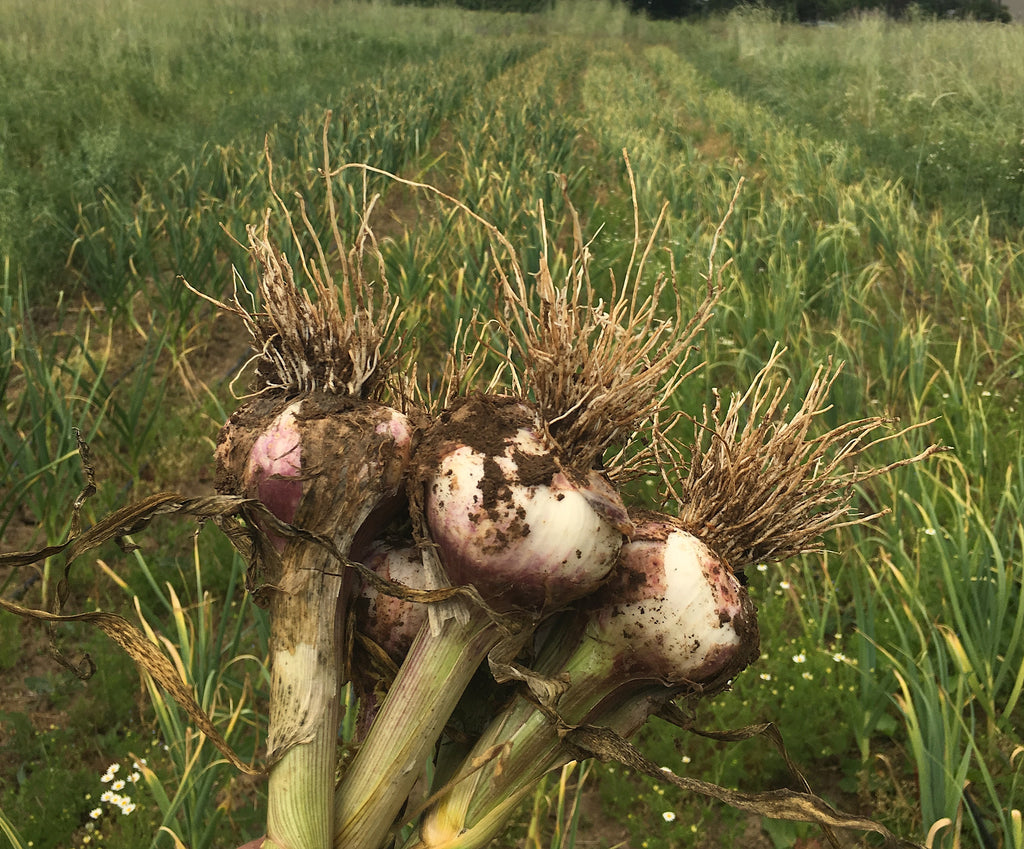The summer solstice just passed and your garlic is likely beginning to form distinct bulbs. Garlic is one of my favorite crops to grow at home. I love being able to grow different varieties that are nearly impossible to find at a grocery store. Garlic has an incredibly long history of human cultivation. Each clove is a remnant of another time, another place, another garden.
I just finished reading Growing Great Garlic by Ron Engeland, a really inspiring book that has left me feeling all sorts of warm dreamy feelings about garlic. It talks about the history and includes in-depth cultivation steps. However the book ends without mentioning what to plant after garlic. So I thought I might share a little on the topic with you today.
What Next & Why?
As you prepare for your harvest you probably will find yourself thinking not only about all the delicious food you will make. It is also a great time to think about what you might want to grow after your harvest.
Depending on the size of your garden and where you are gardening there are a number of different pathways to take. You may be ready to plant your fall garden starts, perhaps you want to let the area rest for a while or maybe it is time to rebuild the soil and plant a cover crop.
There are also a number of diseases and pests that can occur if alliums are grown in the same place year after year. A general rule is to employ a three year rotation for your allium crops. Alliums include:
- Garlic
- Leeks
- Onions
- Chives ect.
They are considered to be heavy feeders, pulling nitrogen, potassium and phosphorus from the soil as well as lots of other trace minerals. So besides not planting more garlic in the same spot what should you do?
1. Prep the Soil
If you plan on planting after you harvest, you will want to do some work on your garden bed to get it ready for planting:
- Pull out any weeds that may have taken hold. Remove any debris remaining from your garlic.
- Add a few inches of compost to the bed. You can incorporate the compost with a digging fork or with a rake.
- Rake the bed flat to create a nice space for planting. You could add other fertilizer at this point, such as aged manure.
If your crop did not perform as well as you had hoped it could be time to test the soil. Check the pH and the nutrient levels to get a good idea of what your soil needs. You should perform these tests before you add compost and fertilizer. I generally like low till methods the best in gardening, and find the soil texture after garlic to be fairly nice.
Purple Sunrise Radish, Siskiyou Seeds
2. What to Plant
You can plant a plethora of different crops after garlic - just make sure you steer clear of any other alliums like leeks or onions. As it is likely to be at least mid July by the time you are ready to plant in your old garlic bed, make sure you know your first fall frost date. You can find your first fall frost date easily by searching for which growing zone your garden is in. In Southern Oregon, our first frost date is around the beginning of October. If you live in a more mild climate you will have a broader range of crops that you can plant. You might have time for beans or even summer squash.
I choose to plant fall greens after my garlic. These plantings tend to do quite well after a garlic crop:
Maybe a mix of all of those things if you are gardening with high density and diversity. Generally, crops planted for the fall garden should be almost totally mature by the time your first fall frosts come. You can protect your fall crops with floating row cover. Fully mature plants usually have a greater chance of surviving light frosts as well.
Cool Season Cover Crop (Favas in Bloom!)
3. Consider Cover Crop!
If you felt your garden bed was depleted after the garlic or if you are depleted after your garlic harvest then you could consider planting a cover crop. You might not want to deal with a fall garden which is totally fine. Cover cropping is an excellent way to protect your soil from winter weather and compaction. It also helps rebuild soil structure and nutrients. The best cover crops are a blend of a few different things. I like to look for a cover crop with peas, oats, rye and another legume in it. Since it is only mid July you have time for a buckwheat cover crop. Buckwheat grow and finishes quite quickly and you could then follow with a cool season cover crop in mid September. To read more about cover cropping check out our blog post on the topic.
Happy planting!
Taryn Hunter





Comments (0)